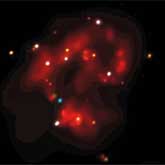What Powered the Big Bang?
 During the last decade, sky maps of the radiation relic of the Big Bang---first by NASA's Cosmic Background Explorer (COBE) satellite and more recently by other experiments, including Antarctic balloon flights and NASA's Wilkinson Microwave Anisotropy Probe (WMAP)---have displayed the wrinkles imprinted on the Universe in its first moments. Gravity has pulled these wrinkles into the lumpy Universe of galaxies and planets we see today. Yet still unanswered are the questions: why was the Universe so smooth before, and what made the tiny but all-important wrinkles in the first place?
During the last decade, sky maps of the radiation relic of the Big Bang---first by NASA's Cosmic Background Explorer (COBE) satellite and more recently by other experiments, including Antarctic balloon flights and NASA's Wilkinson Microwave Anisotropy Probe (WMAP)---have displayed the wrinkles imprinted on the Universe in its first moments. Gravity has pulled these wrinkles into the lumpy Universe of galaxies and planets we see today. Yet still unanswered are the questions: why was the Universe so smooth before, and what made the tiny but all-important wrinkles in the first place?
Quantum fluctuations during the Big Bang are imprinted in gravitational waves, the cosmic microwave background, and in the structure of today's Universe. Studying the Big Bang means detecting those imprints. Einstein's theories led to the Big Bang model, but they are silent on these questions as well as the simplest: 'What powered the Big Bang?' Modern theoretical ideas that try to answer these questions predict that the wrinkles COBE discovered arose from two kinds of primordial particles: of the energy field that powered the Big Bang; and gravitons, fundamental particles of space and time.
Measurements by missions of the Beyond Einstein program could separate these different contributions, allowing us to piece together the story of how time, space, and energy worked together to power the Big Bang.
About the Author
NASA Goddard Space Flight Center
 The Goddard Space Flight Center is a major NASA space research laboratory located approximately 6.5 miles northeast of Washington, D.C. in Greenbelt, Maryland, United States.
The Goddard Space Flight Center is a major NASA space research laboratory located approximately 6.5 miles northeast of Washington, D.C. in Greenbelt, Maryland, United States.


